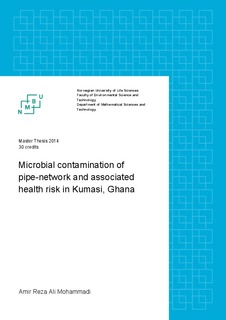| dc.contributor.author | Ali Mohammadi, Amir Reza | |
| dc.date.accessioned | 2014-09-23T11:32:04Z | |
| dc.date.available | 2014-09-23T11:32:04Z | |
| dc.date.copyright | 2014 | |
| dc.date.issued | 2014-09-23 | |
| dc.identifier.uri | http://hdl.handle.net/11250/221157 | |
| dc.description.abstract | Having access to piped water on premises is commonly related to clean and safe drinking water, in both developed and developing countries. Even though relatively few studies have been done on the subject, they show poor drinking water quality have been associated with piped water on premises. In some cases, the water quality from piped water at the point of use is unsafe for consumption than other water sources such as private boreholes and wells used by the people.
The main reason for the poor quality of piped water on premises is the contamination of water in the distribution network of the water supply system. Several waterborne disease outbreaks have been associated with the contamination of the water distribution network.
The purpose of this study was to compare the water quality and assess the microbial health risk for piped water in slum and non-slum areas. The study was conducted in Kumasi, Ghana. Ten sampling points were selected from each area and a total 166 water samples were collected over a period of five weeks 79 from the slum area and 87 from the non- slum area. The study assessed the levels of Escherichia coli, Escherichia coli O157:H7 and Salmonella in the water samples.
This study showed that 25.9% (43/116) of the samples contained Escherichia coli, 19% (15/79) in the slum area and 32% (28/87) in the non- slum area. Escherichia coli O157:H7 was only detected in one sample from the slum area and none from the non-slum area throughout the study period. Salmonella was not detected in any of the samples in both study areas. By applying the extrapolation method, the risk of being infected by the norovirus was set to 4.86 x 10−3 for the slum area and 7.02 x 10−3 for the non- slum area. The risk for being infected by E. coli O157:H7 was 1.24 x 10−8 for the slum area and 2.19 x 10−8for the non-slum area. At last the risk of being infected by salmonella in the slum area was respectively 3.18 x 10−7 and 5.51 x 10−7 in the nonslum.
Because of the poor water quality, recommendation for further investigations and studies is suggested, and investment in the old pipe network is necessary due to the poor water quality delivered to consumer trough the distribution system can cause health risk to the population in Kumasi. | nb_NO |
| dc.language.iso | eng | nb_NO |
| dc.publisher | Norwegian University of Life Sciences, Ås | |
| dc.rights | CC0 1.0 Universal | * |
| dc.rights.uri | http://creativecommons.org/publicdomain/zero/1.0/ | * |
| dc.subject | Water distribution | nb_NO |
| dc.subject | E. coli O157:H7 | nb_NO |
| dc.subject | Salmonella | nb_NO |
| dc.subject | QMRA | nb_NO |
| dc.title | Microbial contamination of pipe-network and associated health risk in Kumasi, Ghana | nb_NO |
| dc.type | Master thesis | nb_NO |
| dc.subject.nsi | VDP::Technology: 500::Building technology: 530::Hydrotechnology: 538 | nb_NO |
| dc.subject.nsi | VDP::Medical disciplines: 700::Health sciences: 800 | nb_NO |
| dc.source.pagenumber | 60 | nb_NO |
| dc.description.localcode | M-VM | nb_NO |

